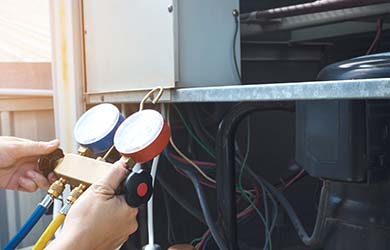
Air conditioners provide unrivaled comfort, especially during the summer. One thing most homeowners dread is our air conditioners failing right when we need them most.
When your air conditioner fails to cool your home, the first step is to diagnose the problem. While there are many possible causes, one of the most common reasons is that your AC is running low on refrigerant.
Refrigerant loss most likely stems from a leak, which is why it’s important to find out right away if you have one.
There are many ways to find out if your air conditioner is losing refrigerant. You can try tests that range from simple to more advanced to find out if your system has a leak and determine the best course of action.
First, let’s learn more about refrigerants and how they work.
Jump to Key Points:
- What Is AC Refrigerant?
- How Often To Check Refrigerant Levels
- How To Check for Air Conditioner Leaks
- Check Your Air Conditioner’s Cooling Cycle
- What To Do if Your AC Is Low in Refrigerant
What Is AC Refrigerant?
Refrigerants are crucial components of your AC’s cooling process. It’s basically what makes it possible for your unit to cool your home.
A refrigerant is a compound that can change from one state to another. As it travels through your air conditioner’s inner components, it transitions from a low-pressure gas to a high-pressure liquid. This process allows your air conditioner to absorb heat and provide cold air for your home.
Throughout the life of your AC system, you may need to refill its refrigerant at least once.
How Often Should You Check Your Refrigerant Levels?
There’s no urgent need to measure AC refrigerant levels if your unit is working fine. However, you may need to check your air conditioner if it starts exhibiting some problems.
Here are some warning signs that your air conditioning unit may be low on refrigerant:
- AC blowing warm air: Although there are many other reasons for your AC to blow warm air, it’s one of the telltale signs that your unit is running low on refrigerant.
- AC takes a long time to cool the room: Your air conditioner may be low on refrigerant if it takes a longer time to cool your home.
- Ice & frost: A refrigerant leak can cause ice or frost to form on the refrigerant lines. If you notice any signs of freezing, your AC may be leaking and running low on refrigerant.
- Noises coming from the AC: A bubbling or hissing sound coming from your AC is a clear sign that it has a leak and is losing refrigerant.
- Rising utility bills: If you notice your energy bills are way higher when your usage has stayed the same, it may be because your AC is working twice as hard to cool your home. This can be attributed to a leak.
How Do I Check for Leaks in an Air Conditioner?
Before you have your refrigerant levels checked, there are some ways you can find out if your AC leaks in the first place. Discovering a leak can let you know what steps to take to fix your AC’s problems.
Here are some ways you can check for a refrigerant leak:
A quick inspection of the air conditioner
If your AC is already showing some warning signs that refrigerant is leaking, you may want to do a further check to write off other potential reasons behind your AC’s problems.
First, check the fan. If it isn’t running, the problem is not likely to be connected to a leak. Check the air filters as well. If routine cleaning solves the problem, it’s likely your AC isn’t leaking refrigerant.
Do the soap/bubble test
This tried-and-tested technique is simple and has been a go-to method for many HVAC technicians. First, a soap solution is made using dishwashing soap and water.
Some companies also offer soap solutions specifically made for detecting leaks. The solution is sprayed onto certain areas of the air conditioner’s interior, especially where a leak is suspected to have formed. If there are any leaks, bubbles will form.
Use the dye method
Leaks in your AC can be detected with the use of UV fluorescent dye. The dye is injected into your air conditioner and allowed to travel all through the system by running the machine.
If there are any leaks, the dye will show up when exposed to a UV lamp. If you can’t see any dye on the air conditioner’s parts, try checking if there’s any dripping onto the ground. If you see any dye, your AC needs to be serviced as soon as possible.
Use an electronic leak detector
Using an electronic detector is one way to get a very accurate reading on whether your AC has a leak and needs a recharge.
There are many types of electronic detectors on the market, but these are the most common ones that give a highly accurate reading:
- Heating diode: Heating diode detectors identify a leak when refrigerant comes into contact with its heated ceramic diode. When contact happens, the device sounds an alarm, informing you of the leak.
- Ultrasonic: An ultrasonic detector can detect leaks in an AC using sound waves. The sound gas makes when it escapes is around 25kHz to 10MHz. Although humans can’t hear this frequency, the device detects it and informs you that your AC has a refrigerant leak.
- Infrared: Infrared thermography can be used to detect leaks. The difference in temperature between the leaking gas and the air around it will show up in the device and let you know if there’s a leak.
Test Your Air Conditioner’s Cooling Cycle
Superheating and sub-cooling are important concepts in the cooling cycle. Measuring them can let you know if your AC leaks. This isn’t a simple procedure if you don’t have equipment or HVAC experience.
If you’re sure about testing your AC yourself, here’s how you can do it:
Step 1:
Prepare your equipment. You’ll need a digital thermometer, a refrigerant slider (this is available to download as an app), and some pen and paper. If your AC doesn’t have built-in pressure gauges, you can use a refrigerant gauge set with hoses.
Step 2:
Check the type plate on your air conditioner’s outside unit. This plate will show you the type of refrigerant your AC uses.
Step 3:
Check the discharge pressure (low pressure) and suction pressure (high pressure) from your unit’s gauges. If your unit doesn’t have one, check using a refrigerant gauge set. Write down the readings.
Step 4:
Check your AC’s evaporation and condensation temperature using a refrigerant slider. Input the correct refrigerant and set the slide on “dew.” Type in the low-pressure reading to see the evaporation temperature.
To get the condensation temperature, set the slider to “bubble” and input the high-pressure reading. Take note and write down these temperatures.
Step 5:
Use your digital thermometer to measure the temperatures on your AC. Measure the superheating at the suction pipe, and measure the sub-cooling at the discharge pipe before the expansion valve. Write down the temperature readings.
Step 6:
Calculate the superheating and sub-cooling. Superheating is when you heat vapor above its boiling point for evaporation to happen.
In a cooling unit, the difference between the boiling point and superheating must be 10 Kelvin. Meanwhile, sub-cooling is when you cool a vapor below its condensation point. The temperature difference here must be 5 Kelvin.
Step 7:
Subtract the evaporation temperature from the suction pipe temperature. That’s your superheating result. Now, subtract the discharge pipe temperature from the condensation temperature. That’s your sub-cooling result.
Formulas:
Superheating = Suction pipe temp. – Evaporation temp.
Sub-cooling = Condensation temp. – Discharge pipe temp.
Step 8:
Check your results if they’re within the 10 Kelvin and 5 Kelvin ranges. If your results are off, your AC most likely needs to be repaired and given a refrigerant refill.
While some of these methods seem simple enough, if you’re not well-versed in HVAC systems, you may end up misdiagnosing your AC. You may either be careless with the dye and find leaks that aren’t there, or you may miss an actual leak and continue to run your AC until you run out of refrigerant.
At the same time, trying to do the more complicated methods can be difficult, especially if you don’t have the proper equipment and experience. You may end up causing harm to yourself and your AC.
To avoid these possibilities, it’s recommended to hire licensed technicians to take a look at your AC system. If you suspect that your machine leaks, call for an air conditioning repair immediately.
What To Do When Your AC Is Low on Refrigerant
There are ways you can refill your air conditioner’s refrigerant. This process is often called “recharging,” and you’ll need a few tools to accomplish it. However, it’s not recommended to do recharging on your own.
Refrigerant poisoning is a real threat. Minimal exposure can lead to skin and eye irritation and breathing problems. Longer exposure can lead to nausea, vomiting, headaches, and even seizures. Very close and strong exposure can lead to fainting and even sudden death.
There’s no need to endanger yourself and your loved ones. If you think your AC refrigerant needs to be refilled, call for air conditioning maintenance right away.
Mac 5 Services Expert Home Services
If you need any assistance with refrigerant concerns, don’t settle for less. Call a licensed technician to come and help you.
Whether you need to have your refrigerant levels tested or if you need a leak fixed, we can provide top-quality services no matter the model or make of your AC.
We provide expert HVAC services in Melbourne, Florida. We do AC repair and maintenance and air conditioning installation as well.
Call us today at (321) 244-7500 to learn more and schedule service.



